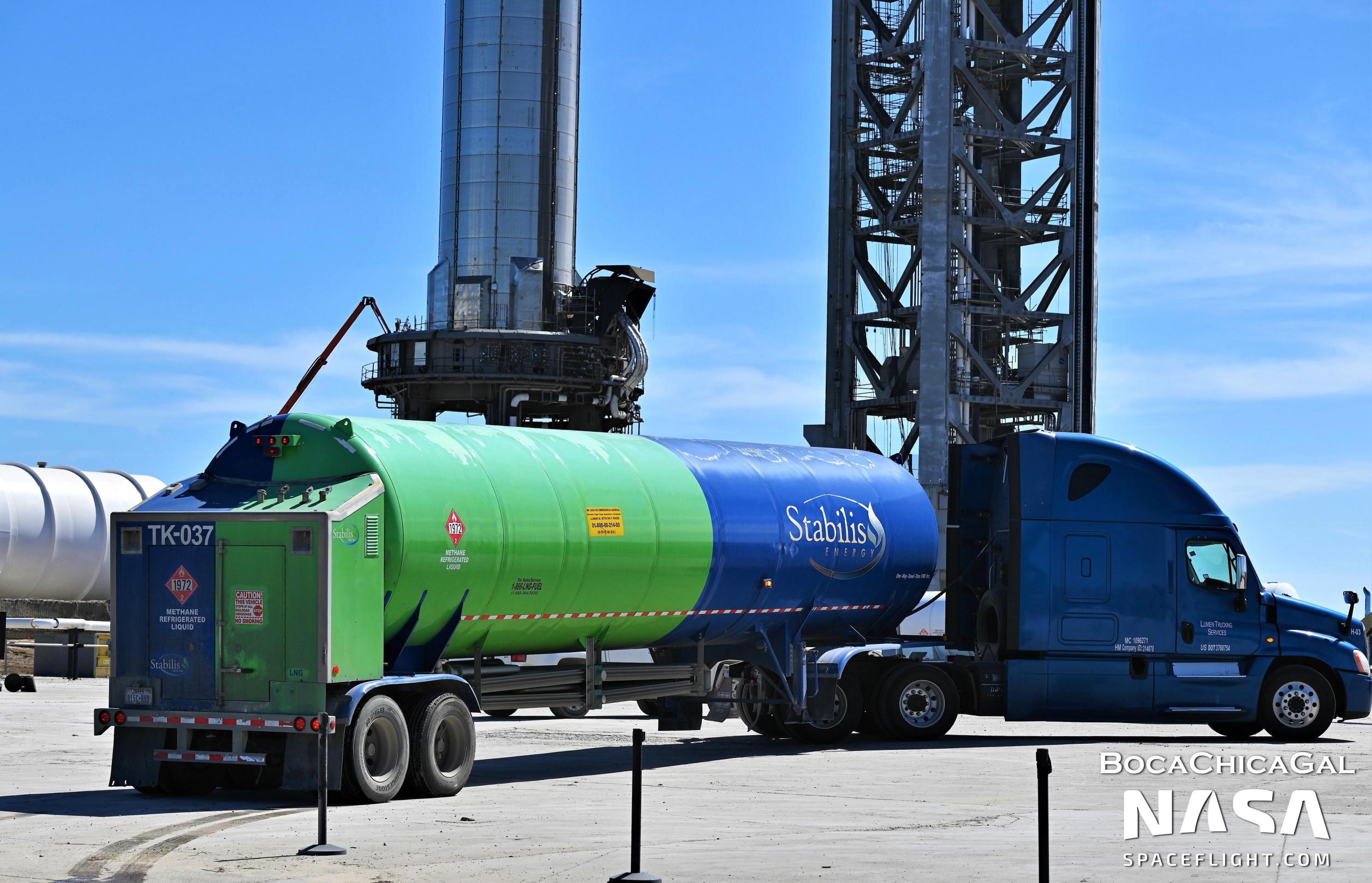
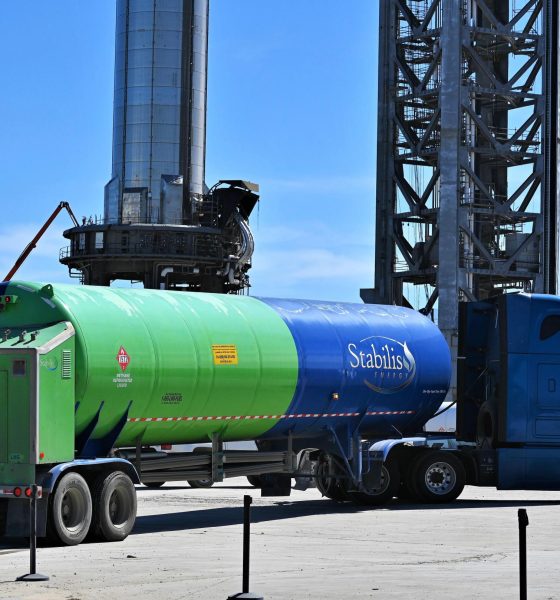
News
SpaceX has finally begun filling Starship’s orbital launch site fuel tanks
Almost five months after SpaceX began the process of filling and testing the first custom-built propellant storage system for Starship, the largest rocket ever built, the company has finally begun to fill the fuel half of the ‘tank farm’.
SpaceX began delivering truckloads of liquid nitrogen (LN2) to the LN2 and liquid oxygen (LOx) sections of the tank farm in mid-September 2021, well before the farm was anywhere close to completion. In about a month, SpaceX accepted ~60 LN2 deliveries – enough to partially fill one of the farm’s seven cryogenic tanks. Instead of some operational purpose, that LN2 was likely used to clean and partially proof the farm’s three LOx tanks. Just two weeks later, the orbital tank farm received its first LOx deliveries.
At the time, mere days after the basic structure of the main tank farm storage system was effectively completed, most figured that it would take SpaceX about as long to clean, proof, and begin filling the farm’s two liquid methane tanks. That would not be the case.
SpaceX installed the second of the farm’s two vertical SpaceX-built cryogenic liquid methane (LCH4) tanks in mid-October 2021. All seven cryogenic tanks had ‘sleeves’ – designed to be filled with foam insulation – installed by the end of the month, effectively completing the farm’s basic structure half a year after assembly began. However, around the same time, SpaceX also installed two horizontal tanks that were also identified as LCH4 storage – giving the overall tank farm far more fuel storage than its oxidizer (LOx) tanks could match. Starship’s Raptor engines burn about 3.55 kilograms of LOx for every 1 kilogram of LCH4.
As work on the vertical LCH4 tanks appeared to slow to a crawl, it took until December 2021 for SpaceX to begin cleaning and proofing the farm’s horizontal LCH4 tanks with liquid nitrogen. By that time, a rough unofficial narrative had been constructed to explain the lack of progress on the farm’s fuel half. Namely, in an excellent Twitter thread, CSI Starbase made a strong case that SpaceX appeared to have designed the first orbital-class Starship tank farm – a compact and pleasingly symmetric set of eight vertical storage tanks – without taking into consideration rudimentary Texas regulations for the storage of liquid natural gas and methane. By all appearances, that conclusion was correct, as the farm was visibly violating several rules – namely the requirements that all LCH4 storage be surrounded by six-foot-tall retaining walls and that all associated plumbing not be situated under power cabling.
As it exists, the LCH4 side of the vertical tank farm violates both of those rules and it’s not obvious that there is actually enough space between the two vertical methane tanks to build a retaining wall with two feet of horizontal clearance. It’s possible that the situation is more complex and that SpaceX intentionally broke those rules or was pursuing an exception to them but the end result was that those vertical LCH4 tanks have yet to be finished, let alone cleaned or proof tested. Instead, SpaceX appears to have fully refocused on horizontal tanks and most recently tore down a dirt berm beside them and began preparing foundations for at least two or three more.
Those horizontal tanks appear to store about 1000 cubic meters (~35,000 ft^3) of LCH4, while the vertical tanks would have stored about 1800 m^3. To fully replace them, SpaceX will need approximately four horizontal tanks – two more in addition to the two already installed. Thankfully, SpaceX has finally begun filling the already installed tanks while it works to expand the methane farm, beginning with three truckloads on the very first day – February 13th, 2022.
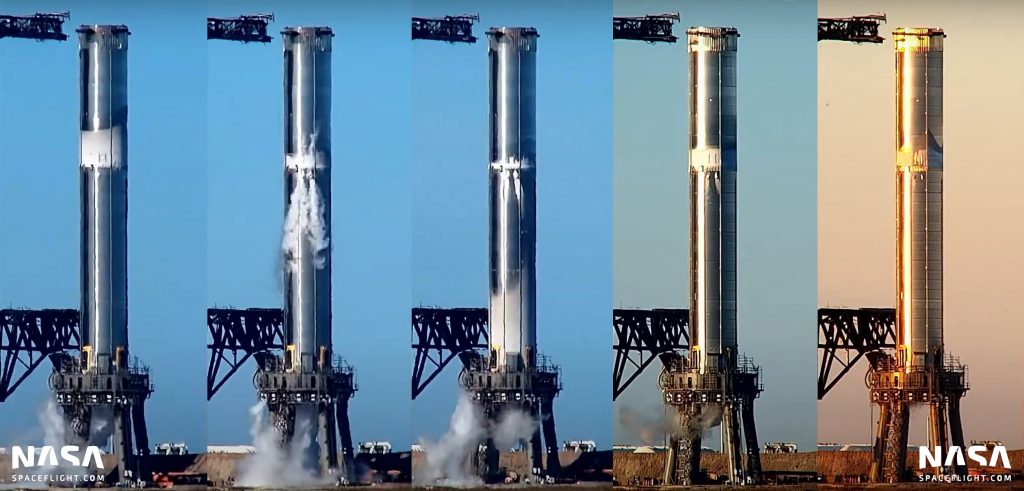
To fill the two existing tanks, which may store enough methane to fuel a stacked Starship and Super Heavy about 4/5ths of the way, SpaceX will need around 40-50 more tanker deliveries. Since last November, SpaceX has completed more than 320 liquid nitrogen and 200 liquid oxygen deliveries – equivalent to about 6700 tons (~14.8M lb) of LN2 and 4200 tons (~9.3M lb) of LOx. If SpaceX maintains that average and focuses entirely on LCH4, the two horizontal tanks could be filled to the brim before the end of February.
Having a substantial amount of LCH4 stored at the orbital tank farm will finally allow SpaceX to attempt the first major wet dress rehearsals (WDRs) and, more importantly, the first full static fires with flightworthy Super Heavy booster prototypes. Of course, a tank farm with full supplies of LOx, LCH4, LN2, and their gaseous equivalents is also a necessity for the first orbital Starship launch attempt, which has most recently slipped from a target of mid-2021 to no earlier than (NET) Q2 2022, pending regulatory approval.

News
Tesla (TSLA) receives “Buy” rating and $551 PT from Canaccord Genuity
He also maintained a “Buy” rating for TSLA stock over the company’s improving long-term outlook, which is driven by autonomy and robotics.
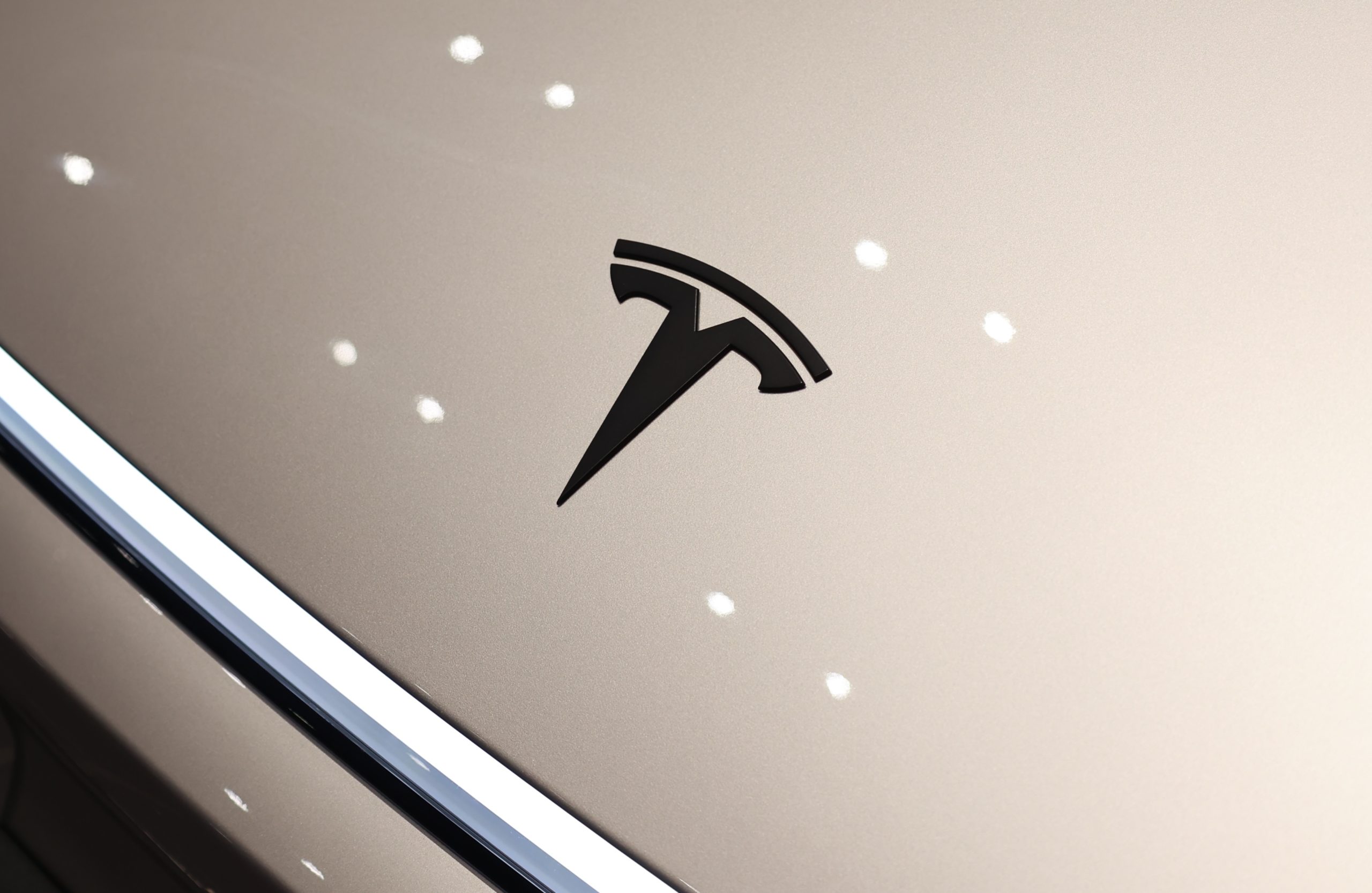
Canaccord Genuity analyst George Gianarikas raised his Tesla (NASDAQ:TSLA) price target from $482 to $551. He also maintained a “Buy” rating for TSLA stock over the company’s improving long-term outlook, which is driven by autonomy and robotics.
The analyst’s updated note
Gianarikas lowered his 4Q25 delivery estimates but pointed to several positive factors in the Tesla story. He noted that EV adoption in emerging markets is gaining pace, and progress in FSD and the Robotaxi rollout in 2026 represent major upside drivers. Further progress in the Optimus program next year could also add more momentum for the electric vehicle maker.
“Overall, yes, 4Q25 delivery expectations are being revised lower. However, the reset in the US EV market is laying the groundwork for a more durable and attractive long-term demand environment.
“At the same time, EV penetration in emerging markets is accelerating, reinforcing Tesla’s potential multi‑year growth runway beyond the US. Global progress in FSD and the anticipated rollout of a larger robotaxi fleet in 2026 are increasingly important components of the Tesla equity story and could provide sentiment tailwinds,” the analyst wrote.
Tesla’s busy 2026
The upcoming year would be a busy one for Tesla, considering the company’s plans and targets. The autonomous two-seat Cybercab has been confirmed to start production sometime in Q2 2026, as per Elon Musk during the 2025 Annual Shareholder Meeting.
Apart from this, Tesla is also expected to unveil the next-generation Roadster on April 1, 2026. Tesla is also expected to start high-volume production of the Tesla Semi in Nevada next year.
Apart from vehicle launches, Tesla has expressed its intentions to significantly ramp the rollout of FSD to several regions worldwide, such as Europe. Plans are also underway to launch more Robotaxi networks in several more key areas across the United States.
News
Waymo sues Santa Monica over order to halt overnight charging sessions
In its complaint, Waymo argued that its self-driving cars’ operations do not constitute a public nuisance, and compliance with the city’s order would cause the company irreparable harm.
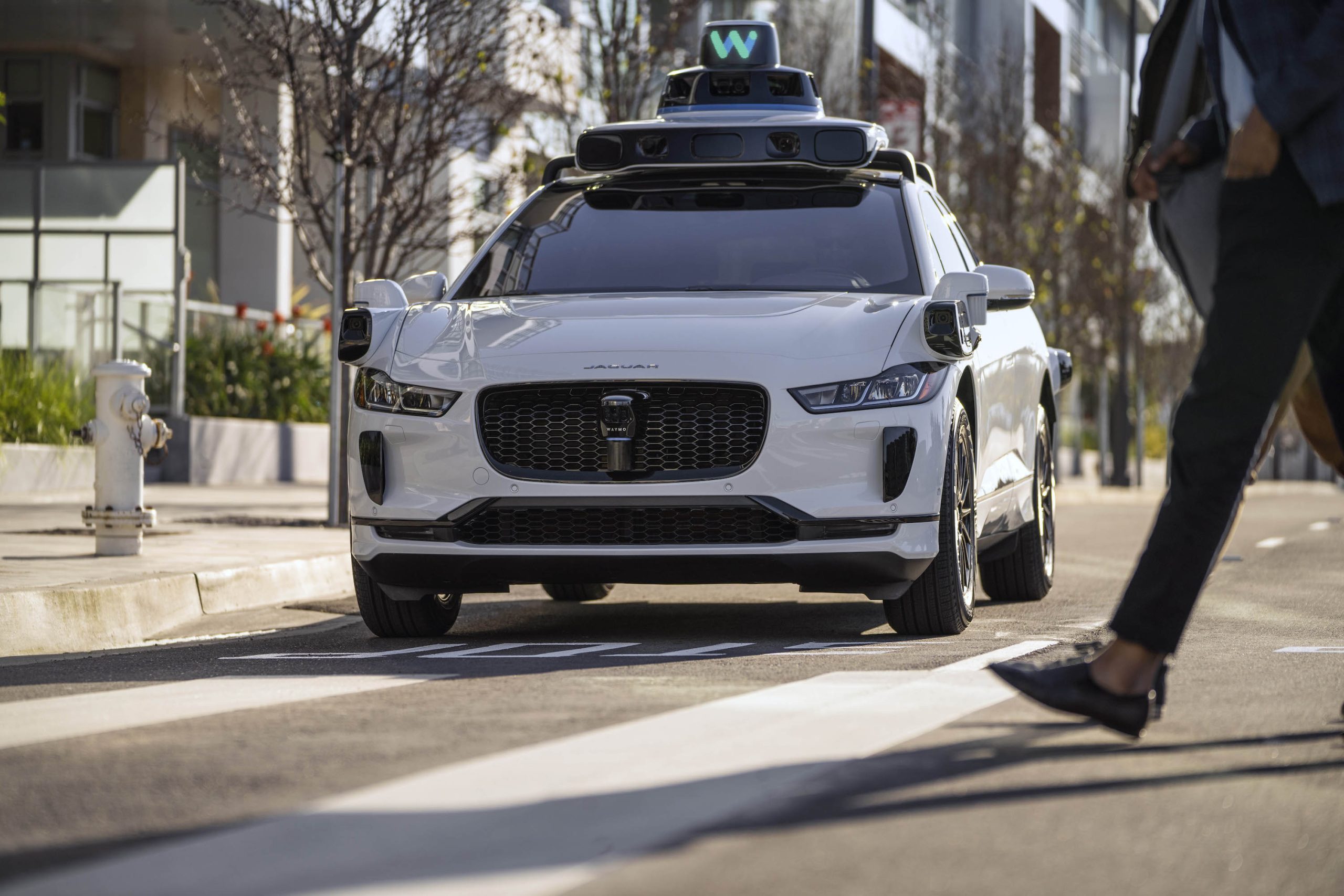
Waymo has filed a lawsuit against the City of Santa Monica in Los Angeles County Superior Court, seeking to block an order that requires the company to cease overnight charging at two facilities.
In its complaint, Waymo argued that its self-driving cars’ operations do not constitute a public nuisance, and compliance with the city’s order would cause the company irreparable harm.
Nuisance claims
As noted in a report from the Los Angeles Times, Waymo’s two charging sites at Euclid Street and Broadway have operated for about a year, supporting the company’s growing fleet with round-the-clock activity. Unfortunately, this has also resulted in residents in the area reportedly being unable to sleep due to incessant beeping from self-driving taxis that are moving in and out of the charging stations around the clock.
Frustrated residents have protested against the Waymos by blocking the vehicles’ paths, placing cones, and “stacking” cars to create backups. This has also resulted in multiple calls to the police.
Last month, the city issued an order to Waymo and its charging partner, Voltera, to cease overnight operations at the charging locations, stating that the self-driving vehicles’ activities at night were a public nuisance. A December 15 meeting yielded no agreement on mitigations like software rerouting. Waymo proposed changes, but the city reportedly insisted that nothing would satisfy the irate residents.
“We are disappointed that the City has chosen an adversarial path over a collaborative one. The City’s position has been to insist that no actions taken or proposed by Waymo would satisfy the complaining neighbors and therefore must be deemed insufficient,” a Waymo spokesperson stated.
Waymo pushes back
In its legal complaint, Waymo stated that its “activities at the Broadway Facilities do not constitute a public nuisance.” The company also noted that it “faces imminent and irreparable harm to its operations, employees, and customers” from the city’s order. The suit also stated that the city was fully aware that the Voltera charging sites would be operating around the clock to support Waymo’s self-driving taxis.
The company highlighted over one million trips in Santa Monica since launch, with more than 50,000 rides starting or ending there in November alone. Waymo also criticized the city for adopting a contentious strategy against businesses.
“The City of Santa Monica’s recent actions are inconsistent with its stated goal of attracting investment. At a time when the City faces a serious fiscal crisis, officials are choosing to obstruct properly permitted investment rather than fostering a ‘ready for business’ environment,” Waymo stated.
News
Tesla FSD v14.2.2 is getting rave reviews from drivers
So far, early testers have reported buttery-smooth drives with confident performance, even at night or on twisty roads.

Tesla Full Self-Driving (Supervised) v14.2.2 is receiving positive reviews from owners, with several drivers praising the build’s lack of hesitation during lane changes and its smoother decision-making, among others.
The update, which started rolling out on Monday, also adds features like dynamic arrival pin adjustment. So far, early testers have reported buttery-smooth drives with confident performance, even at night or on twisty roads.
Owners highlight major improvements
Longtime Tesla owner and FSD user @BLKMDL3 shared a detailed 10-hour impression of FSD v14.2.2, noting that the system exhibited “zero lane change hesitation” and “extremely refined” lane choices. He praised Mad Max mode’s performance, stellar parking in locations including ticket dispensers, and impressive canyon runs even in dark conditions.
Fellow FSD user Dan Burkland reported an hour of FSD v14.2.2’s nighttime driving with “zero hesitations” and “buttery smooth” confidence reminiscent of Robotaxi rides in areas such as Austin, Texas. Veteran FSD user Whole Mars Catalog also demonstrated voice navigation via Grok, while Tesla owner Devin Olsen completed a nearly two-hour drive with FSD v14.2.2 in heavy traffic and rain with strong performance.
Closer to unsupervised
FSD has been receiving rave reviews, even from Tesla’s competitors. Xpeng CEO He Xiaopeng, for one, offered fresh praise for FSD v14.2 after visiting Silicon Valley. Following extended test drives of Tesla vehicles running the latest FSD software, He stated that the system has made major strides, reinforcing his view that Tesla’s approach to autonomy is indeed the proper path towards autonomy.
According to He, Tesla’s FSD has evolved from a smooth Level 2 advanced driver assistance system into what he described as a “near-Level 4” experience in terms of capabilities. While acknowledging that areas of improvement are still present, the Xpeng CEO stated that FSD’s current iteration significantly surpasses last year’s capabilities. He also reiterated his belief that Tesla’s strategy of using the same autonomous software and hardware architecture across private vehicles and robotaxis is the right long-term approach, as it would allow users to bypass intermediate autonomy stages and move closer to Level 4 functionality.








